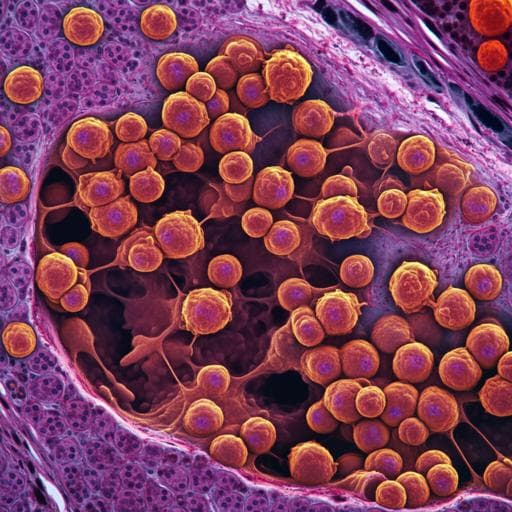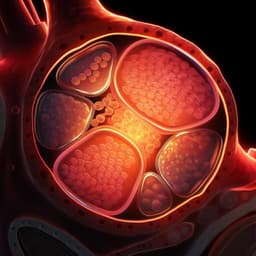
Biology
Multiplexed histology analyses for the phenotypic and spatial characterization of human innate lymphoid cells
A. Pascual-reguant, R. Köhler, et al.
This study by Anna Pascual-Reguant and colleagues unveils the intricate world of innate lymphoid cells (ILCs), exploring their localization and interactions within the tonsil microenvironment. By identifying IRF4 as a specific marker for tonsillar ILC3s, the researchers reveal shared niches with plasma cells, paving the way for deeper understanding of ILC biology through advanced histological techniques.
~3 min • Beginner • English
Introduction
Innate lymphoid cells (ILCs) are rare, heterogeneous lymphocytes lacking antigen-specific receptors but sharing transcription factors, chemokine receptors, and cytokine profiles with T cells. They include cytotoxic NK cells and helper ILC1, ILC2, and ILC3, with helper ILCs typically defined as CD45+CD127+ and lineage (Lin)-negative (CD3, CD19, CD14, CD123, CD141, FcεRIα). Because of their tissue-resident nature and roles in inflammation, regeneration, and wound healing, understanding their precise in situ localization and microenvironmental interactions is critical. Conventional immunofluorescence is limited in multiplexing, while emerging multiplex histology methods overcome spectral limitations. However, in situ phenotypic and spatial characterization of human ILCs had not been comprehensively performed. This study aims to develop and apply a highly multiplexed immunofluorescence approach with computational analysis to identify CD127+ ILCs in human tissues, define their niches, and characterize their phenotypes and spatial organization.
Literature Review
Prior work has dissected ILC heterogeneity and developmental trajectories using flow cytometry, single-cell RNA-seq, and mass cytometry, establishing helper ILC subsets and tissue residency. Multiplex histology platforms such as imaging mass cytometry, CODEX, and t-CyCIF, coupled with computational pipelines (e.g., histoCAT), have profiled immune microenvironments, largely in tumor immunology and common immune populations with known localization. Reports have highlighted ILC niches and stromal interactions in murine tissues, but a systematic, spatially resolved, multiparametric analysis of human ILCs in situ was lacking. This work leverages MELC and open-source analysis to fill this gap.
Methodology
Human tissues: Fresh tonsils (tonsillectomy) and colon samples (ulcerative colitis) were obtained with informed consent and ethics approval (University of Freiburg 251/13 140389; Charité EA2/078/16). Tissue processing: 5 µm cryosections on APES-coated coverslips were fixed (2% PFA), permeabilized (0.2% Triton X-100), and blocked (10% goat serum, 1% BSA). MELC imaging: Automated cyclic immunofluorescence using a modified Toponome Image Cycler (Leica DM IRE2, 20x/0.8 NA), with robotic pipetting (CAVRO XL3000). Each cycle: antibody incubation (PE, FITC, DAPI channels), autofocus, imaging (3D ±7 z-steps, 1 µm z-step), photobleaching, post-bleach imaging. Tonsil runs included 53 markers; colon runs included 50 markers, including lineage exclusion, ILC inclusion, phenotypic, and stromal markers. Image pre-processing: Cross-correlation registration to phase-contrast reference; background subtraction using bleaching image or secondary-only control; illumination correction via cubic spline interpolation; extended depth-of-field projection; ImageJ normalization (rolling ball background, edge trimming, intensity stretching to 16-bit). Segmentation and feature extraction: Ilastik (v1.3.2) random forest pixel classification trained on one ROI (~6% of one tonsil dataset) to generate probability maps for nuclei, membranes, and ECM; applied without retraining to additional datasets. CellProfiler (v3.1.8) segmented nuclei (primary) and cells (secondary) using probability maps to produce binary masks. Masks were overlaid on each marker image to extract per-cell mean fluorescence intensities (MFI). Cell classification by thresholding: Manual intensity thresholds (visual inspection) were set per marker to define cell types: ILCs (Lin− CD45+ CD127+; Lin: CD3, CD19, CD20, CD14, CD123, CD141, FcεRIα); B cells (CD45+ CD19+), plasma cells (CD138+), T helper (CD45+ CD3+ CD4+), cytotoxic T (CD45+ CD3+ CD8+), myeloid (CD11c+ and/or CD14+ and/or CD56−CD16+ and/or CD141+), endothelial (CD31+); SMA+ fibroblasts and ECM structures (fibronectin) annotated. Niche analysis: ILC niches defined as 10 µm radius around each ILC; counts and frequencies of immune and stromal components within niches were quantified. Clustering analyses: Dimensionality reduction and clustering with Orange (v3.26.0); t-SNE on per-cell MFIs (tonsil: 52 PCs; colon: 48 PCs; perplexity 30; 1000 iterations). Data transformation and normalization: Arcsinh with cofactor 0.2; pixel intensities normalized to 0–1 scale in CellProfiler. Statistics: One-way or two-way ANOVA with Bonferroni correction (GraphPad Prism 5.04); p-values reported in figures. Validation assays: Flow cytometry on tonsillar mononuclear cells after MACS depletion of CD3+ and CD19+ cells; intracellular TF staining; gating of NK (Lin− CD3− CD45+ CD94+ CD56+), helper ILCs (Lin− CD3− CD45+ CD127+ CD161+), and ILC subsets (c-Kit+ CRTH2− ILC3s; CRTH2+ ILC2s). Transcriptional validation: Microarray analysis of sorted tonsillar ILC3s vs hematopoietic progenitors (GEO GSE63197). Data and pipelines available on Zenodo (DOIs provided in article).
Key Findings
- Multiplexed histology with MELC and an open-source pipeline enabled unambiguous in situ identification of rare CD127+ ILCs alongside major immune and stromal populations in human tonsil and colon tissues.
- Cell detection and quantification: Across five tonsil datasets, 6391 ± 350 cells per field of view were identified. CD127+ ILCs comprised 0.15–0.50% of cells in analyzed tonsil areas; plasma cells and ILCs were rare compared to B and T helper cells.
- ILC niche composition (tonsil): Within 10 µm ILC niches (n=74 niches across n=5 tonsils), plasma cells and T helper cells showed significantly increased absolute numbers per niche (one-way ANOVA with Bonferroni; p=0.0041), while B cells were underrepresented (~10%). Myeloid cells were enriched. Plasma cells accounted for >30% of niche cells. Distributions within niches differed from whole tissue (two-way ANOVA; p=0.0043).
- Proximity to stromal landmarks: 70% of ILCs were within 10 µm of CD31+ vessels and ~80% within 10 µm of fibronectin fibers.
- Tissue compartmentalization (tonsil): No CD127+ ILCs were detected deep within B cell follicles; ~14% ± 4.8 in the T cell zone; 35% ± 10.6 at the follicle border co-localizing with the fibronectin ring; the majority (64% ± 6.3) in the subepithelial connective tissue septum, often in groups of 2–4 cells.
- Clustering validation (tonsil): t-SNE identified nine clusters including an ILC cluster (Lin− CD45+ CD127+ CD161+). Overlap with threshold-based classification: 88.5% of clustered ILCs were pre-classified ILCs, 7.7% pre-classified T cells, 3.8% pre-classified plasma cells. Spatial maps from clustering recapitulated tonsil architecture and ILC/plasma cell co-localization in connective tissue septa.
- ILC3 phenotype and novel marker: Tonsillar ILCs predominantly exhibited ILC3 features (c-Kit+, variable CD7, RANKL, CD69, NKp44). IRF4 protein was detected in a substantial subpopulation of ILC3s by MELC and confirmed by flow cytometry: 62.7% ± 11.30 of Lin− CD45+ CD127+ CD161+ ILCs were IRF4+, and ~98% of these were c-Kit+ CRTH2− ILC3s. IRF4 transcripts were significantly enriched in sorted tonsillar ILC3s compared with CD34+ c-Kit+ and CD34hi c-Kit− progenitors.
- CD138 on ILC3s: CD138 signal was observed on tonsillar ILC3s by MELC and SDC1 transcripts were elevated versus progenitors; however, robust CD138 surface detection on ILCs by flow cytometry was not achieved.
- Colon (ulcerative colitis) datasets (n=2): t-SNE identified nine clusters including ILCs (Lin− CD45+ CD127+; high CD45RO, CCR6, KLRG1; variable CXCR3, CCR6, CD69, ICOS; mostly c-Kitlow/−, Eomes−). ILCs represented <1% of cells. ILC niches showed enrichment of fibroblasts within 10 µm. ILCs tended to form groups of 2–4 near fibronectin and collagen IV fibers around CD31+ vasculature.
- Conserved spatial pattern: Across tissues, CD127+ ILCs associate with vascular and fibroblast-rich stromal landmarks (fibronectin/collagen fibers lining vessels), defining conserved ILC microenvironments.
Discussion
The study addresses the challenge of identifying rare, phenotypically complex ILCs in situ by combining highly multiplexed immunofluorescence with a robust, open-source computational pipeline. This approach reveals that human CD127+ ILCs preferentially reside in stromal-rich, highly vascularized microenvironments and often co-localize with plasma cells in tonsillar connective tissue septa, suggesting shared stromal niches that may support residency and function. Clustering-based analysis validated threshold-based classifications and demonstrated that data-driven methods can sensitively detect rare ILC populations and their spatial distributions. Phenotypically, tonsillar ILCs were enriched for ILC3 markers and unexpectedly expressed IRF4, implicating potential roles for IRF4 in ILC3 maturation or homeostasis, analogous to its functions in B and T cells. Although CD138 was observed on ILC3s by imaging and transcript data, discrepancies with flow cytometry highlight technical and biological nuances (e.g., shedding) of this proteoglycan. Extending the analysis to inflamed colon tissue showed that ILCs, despite differing phenotypes (no IRF4/CD138), shared conserved spatial associations with stromal landmarks, indicating that niche-defining stromal features may guide ILC positioning across tissues. These findings enhance understanding of ILC tissue biology and suggest that spatially defined stromal elements orchestrate ILC localization and potentially their interactions with other immune cells.
Conclusion
This work establishes a multiplexed histology and computational pipeline for the in situ identification and spatial phenotyping of human CD127+ ILCs. Key contributions include: (1) unambiguous detection and quantification of rare ILCs within complex tissues; (2) discovery of IRF4 as a marker of tonsillar ILC3s, validated at protein and transcript levels; (3) definition of conserved stromal landmarks (fibronectin/collagen fibers near vasculature) that characterize ILC niches; and (4) demonstration that ILCs co-localize with plasma cells in tonsillar connective tissue. Future research should: (i) dissect functional roles of IRF4 in ILC3 biology; (ii) verify and mechanistically explore CD138/SDC1 expression in ILCs; (iii) perform 3D spatial analyses to refine niche architecture; (iv) determine proximity to blood versus lymphatic vessels; and (v) functionally interrogate ILC–stromal and ILC–plasma cell interactions in homeostasis and disease.
Limitations
- Subjective thresholding: Initial cell classification relied on manual fluorescence thresholding, which can introduce user bias, although clustering analyses mitigated this.
- Resolution and segmentation constraints: Subcellular resolution and membrane tiling can cause signal spillover between adjacent cells, potentially affecting detection of markers like CD138 on ILCs.
- 2D section analysis: Analyses were performed on 2D sections, which may underestimate cell clustering and niche complexity in 3D.
- Tissue area preselection: FOVs were chosen to include connective tissue septa, which could bias representation of certain cell types or niches.
- Marker discrepancies: CD138 was detected by imaging and transcriptomics but not robustly by flow cytometry, possibly due to proteoglycan shedding during tissue processing.
- Vessel identity: The study did not distinguish blood versus lymphatic vessels in proximity analyses, limiting functional interpretation of vascular associations.
Related Publications
Explore these studies to deepen your understanding of the subject.







